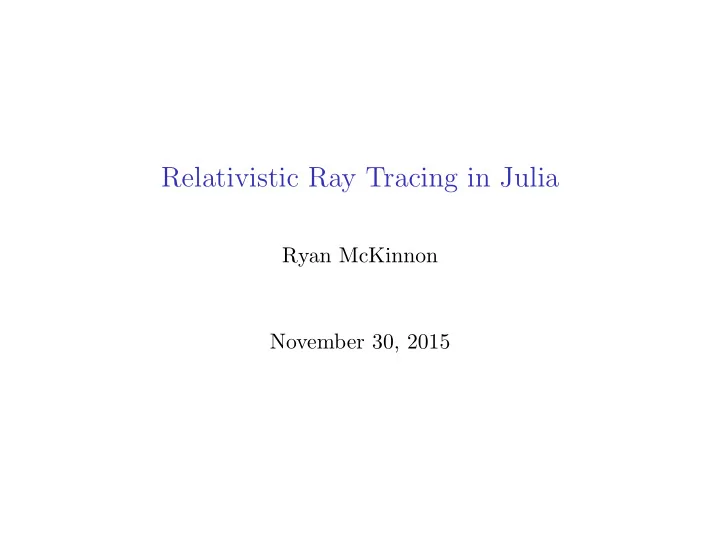

Relativistic Ray Tracing in Julia Ryan McKinnon November 30, 2015
Introduction Ray tracing is used in many scientific fields to visualize 3D data Relativistic ray tracing is needed to model a black hole’s warped spacetime under general relativity This project implements and optimizes a relativistic ray tracer in Julia based on the starless Python code
Methods SharedArrays for shared memory array access ConfParser.jl for reading configuration files at runtime Using Harvard’s Odyssey supercomputer with up to 64 cores per node for a test image of size 1024 by 786; could imagine rendering much bigger scenes Timing comparisons below include parallelization overhead (e.g. assignment of regions of the image to different threads) and ray tracing time, but ignore loading of configuration files, etc.
Ease of Julia Parallelization colour shared = SharedArray ( Float64 , ( numPixels , 3) ) @sync begin f o r ( i , wpid ) in enumerate ( workers () ) @async begin remotecall wait ( wpid , raytrace func , i , schedules [ i ] , colour shared ) end end end Much simpler than in Python, where the multiprocessing module requires you to use a separate array type that you must manually convert to a numpy array!
Optimization Efforts Ray tracing involves lots of vector math and norm computations; use of sumabs2! to compute the norm squared improved performance by 5.8x Another common routine was the Runge-Kutta integrator, which was rewritten inline to eliminate some temporary arrays, speedup of 1.2x Modifying the CHUNKSIZE parameter controlling the number of pixels worked on simultaneously by a thread also helped, speedup of 1.3x In total, improved initial Julia ray tracer by 8.6x
Parallelization Efficiency 10 4 10 3 time (s) 10 2 version 1 version 2 version 3 version 4 example 1/N scaling 10 1 10 0 10 1 N
Other Opportunities for Improvement MPI or distributed array programming is a natural extension Perhaps an even more efficient way to compute norms? More advanced integration routines that adaptively determine number of integration steps (rather than some fixed number)
Summary Implemented a relativistic ray tracer in Julia based on starless Python code Parallelization (threading, SharedArrays) and optimization tweaks significantly improved performance Parallelization easier to implement in Julia than Python!
Recommend
More recommend